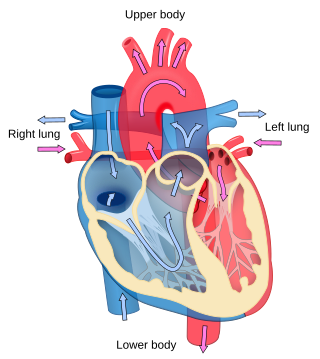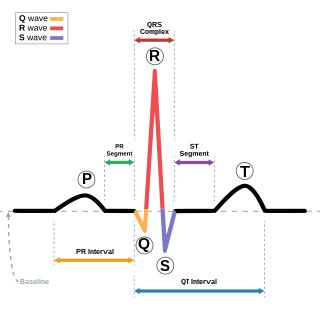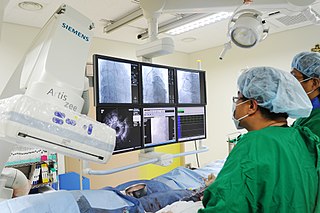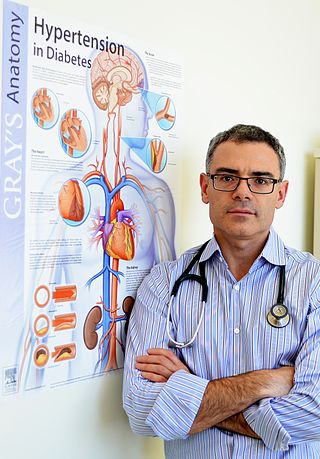Related Research Articles

Cardiology is the study of the heart. Cardiology is a branch of medicine that deals with disorders of the heart and the cardiovascular system. The field includes medical diagnosis and treatment of congenital heart defects, coronary artery disease, heart failure, valvular heart disease, and electrophysiology. Physicians who specialize in this field of medicine are called cardiologists, a sub-specialty of internal medicine. Pediatric cardiologists are pediatricians who specialize in cardiology. Physicians who specialize in cardiac surgery are called cardiothoracic surgeons or cardiac surgeons, a specialty of general surgery.

Wolff–Parkinson–White syndrome (WPWS) is a disorder due to a specific type of problem with the electrical system of the heart involving an accessory pathway able to conduct electrical current between the atria and the ventricles, thus bypassing the atrioventricular node. About 60% of people with the electrical problem developed symptoms, which may include an abnormally fast heartbeat, palpitations, shortness of breath, lightheadedness, or syncope. Rarely, cardiac arrest may occur. The most common type of irregular heartbeat that occurs is known as paroxysmal supraventricular tachycardia.

Cardiac electrophysiology is a branch of cardiology and basic science focusing on the electrical activities of the heart. The term is usually used in clinical context, to describe studies of such phenomena by invasive (intracardiac) catheter recording of spontaneous activity as well as of cardiac responses to programmed electrical stimulation - clinical cardiac electrophysiology. However, cardiac electrophysiology also encompasses basic research and translational research components. Specialists studying cardiac electrophysiology, either clinically or solely through research, are known as cardiac electrophysiologists.

Catheter ablation is a procedure that uses radio-frequency energy or other sources to terminate or modify a faulty electrical pathway from sections of the heart of those who are prone to developing cardiac arrhythmias such as atrial fibrillation, atrial flutter and Wolff-Parkinson-White syndrome. If not controlled, such arrhythmias increase the risk of ventricular fibrillation and sudden cardiac arrest. The ablation procedure can be classified by energy source: radiofrequency ablation and cryoablation.

Holiday heart syndrome, also known as alcohol-induced atrial arrhythmias, is a syndrome defined by an irregular heartbeat and palpitations associated with high levels of ethanol consumption. Holiday heart syndrome was discovered in 1978 when Philip Ettinger discovered the connection between arrhythmia and alcohol consumption. It received its common name as it is associated with the binge drinking common during the holidays. It is unclear how common this syndrome is. 5-10% of cases of atrial fibrillation may be related to this condition, but it could be as high as 63%.
Clinical cardiac electrophysiology, is a branch of the medical specialty of cardiology concerned with the study and treatment of rhythm disorders of the heart. Cardiologists with expertise in this area are usually referred to as electrophysiologists. Electrophysiologists are trained in the mechanism, function, and performance of the electrical activities of the heart. Electrophysiologists work closely with other cardiologists and cardiac surgeons to assist or guide therapy for heart rhythm disturbances (arrhythmias). They are trained to perform interventional and surgical procedures to treat cardiac arrhythmia.

Michel Haïssaguerre is a French cardiologist and electrophysiologist. His investigations have been the basis for development of new markers and therapies for atrial and ventricular fibrillation.
The Sensei X robotic catheter is a medical robot designed to enhance a physician’s ability to perform complex operations using a small flexible tube called a catheter. As open surgical procedures that require large incisions have given way to minimally invasive surgeries in which the surgeon gains access to the target organs through small incisions using specialized surgical tools. One important tool used in many of these procedures is a catheter used to deliver many of things a surgeon needs to do his work, to impact target tissue and deliver a variety of medicines or disinfecting agents to treat disease or infection.

Atrial fibrillation is an abnormal heart rhythm (arrhythmia) characterized by rapid and irregular beating of the atrial chambers of the heart. It often begins as short periods of abnormal beating, which become longer or continuous over time. It may also start as other forms of arrhythmia such as atrial flutter that then transform into AF.

A cardiac electrophysiology study is a minimally invasive procedure using catheters introduced through a vein or artery to record electrical activity from within the heart. This electrical activity is recorded when the heart is in a normal rhythm to assess the conduction system of the heart and to look for additional electrical connections, and during any abnormal heart rhythms that can be induced. EP studies are used to investigate the cause, location of origin, and best treatment for various abnormal heart rhythms, and are often followed by a catheter ablation during the same procedure.

Henrick Joan Joost Wellens, M.D., (1935–2020) was a Dutch cardiologist who is considered one of the founding fathers of clinical cardiac electrophysiology - a discipline which enables patients with cardiac arrhythmias to have catheter electrode mapping and ablation.

Arrhythmias, also known as cardiac arrhythmias, are irregularities in the heartbeat, including when it is too fast or too slow. A resting heart rate that is too fast – above 100 beats per minute in adults – is called tachycardia, and a resting heart rate that is too slow – below 60 beats per minute – is called bradycardia. Some types of arrhythmias have no symptoms. Symptoms, when present, may include palpitations or feeling a pause between heartbeats. In more serious cases, there may be lightheadedness, passing out, shortness of breath, chest pain, or decreased level of consciousness. While most cases of arrhythmia are not serious, some predispose a person to complications such as stroke or heart failure. Others may result in sudden death.
Venice Arrhythmias is a biannual international workshop on cardiac arrhythmias, which takes place in Venice, Italy. It was founded in 1989, under the presidency of Dr. Eligio Piccolo, while Dr. Antonio Raviele – current Venice Arrhythmias' President, along with Dr. Andrea Natale – succeeded him on the occasion of the fourth edition, in 1995.

Peter R. Kowey is an American cardiologist and medical researcher. He is Professor of Medicine and Clinical Pharmacology at Jefferson Medical College of Thomas Jefferson University and holds the William Wikoff Smith Chair in Cardiovascular Research at Lankenau Institute for Medical Research.

Yaariv Khaykin is a Canadian cardiologist and a clinical researcher in the area of electrophysiology. He is the director of the Newmarket Electrophysiology Research Group at the Southlake Regional Health Centre. He has published research into complex ablation and pioneered cardiac ablation methods.
Robotic magnetic navigation (RMN) uses robotic technology to direct magnetic fields which control the movement of magnetic-tipped endovascular catheters into and through the chambers of the heart during cardiac catheterization procedures.
Bruce B. Lerman is a cardiologist. He is the Hilda Altschul Master Professor of Medicine at Weill Cornell Medical College, and was chief of the Division of Cardiology and director of the Cardiac Electrophysiology Laboratory at Weill Cornell Medicine and the New York Presbyterian Hospital.
Sanjiv M. Narayan is a British-born American physician, biomedical engineer, and academic researcher. He is a Professor of Medicine at Stanford University. Narayan's work is focused on treating patients with heart rhythm disorders, particularly those with atrial fibrillation. His research applies bioengineering and computational methods to develop improved diagnostic tools and therapy.

Günter Breithardt is a German physician, cardiologist and emeritus university professor. He is known for his research in the field of rhythmology, especially the diagnosis and pharmacological and non-pharmacological therapy of cardiac arrhythmias and acute cardiac death, in particular the identification of arrhythmia-triggering gene mutations. For 21 years he headed the Medical Clinic and Polyclinic C at Münster University Hospital. A number of his academic students hold university management and chief physician positions.
Ganglionated plexi (GP) comprise the intrinsic cardiac autonomic nervous system composed of autonomic ganglia of the heart atrium and ventricles. Cholinergic neurons throughout the GPs project to all areas of the heart, The GP are embedded in the epicardial fat pads, consisting of only a few neurons or as many as 400 neurons. Vagus nerve stimulation has been shown to inhibit the activity of the GP, possibly through Nav1.8.
References
- ↑ Search Results for author Natale A on PubMed .
- ↑ Natale, Andrea; Pisano, Ennio; Shewchik, Jeannie; Bash, Dianna; Fanelli, Raffaele; Potenza, Domenico; Santarelli, Pietro; Schweikert, Robert; White, Richard; Saliba, Walid; Kanagaratnam, Logan; Tchou, Patrick; Lesh, Michael (2000). "First Human Experience With Pulmonary Vein Isolation Using a Through-the-Balloon Circumferential Ultrasound Ablation System for Recurrent Atrial Fibrillation". Circulation. 102 (16): 1879–1882. doi: 10.1161/01.CIR.102.16.1879 . PMID 11034932.
- ↑ "Presidents". Venice Arrhythmias. Archived from the original on 2016-06-24. Retrieved 2016-06-24.
- ↑ "Dr. Andrea Natale, MD - La Jolla - Cardiology, Clinical Cardiac Electrophysiology". Scripps.org. Archived from the original on 2016-08-28. Retrieved 2016-06-24.
- ↑ Circulation. 2011; 123: 104-123 Published online before print December 20, 2010, doi: 10.1161/CIR.0b013e3181fa3cf4
- ↑ "Ablation Maven Andrea Natale Takes Post at Scripps". Theheart.org\accessdate=2016-06-24.
- ↑ Linly, Zack (September 15, 2020). "White Doctor Claims His Daughter Was Attacked in Baltimore by 'a Group of BLM.' Receipts Say That's a Lie". The Root. Archived from the original on September 16, 2020. Retrieved September 16, 2020.
- ↑ Mack, David (September 15, 2020). "A Doctor Went Viral For Saying His Daughter Was Attacked By BLM. She Wasn't". Buzzfeed News. Archived from the original on September 16, 2020. Retrieved September 16, 2020.
- ↑ Fenton, Justin (September 15, 2020). "A Texas cardiologist said his daughter was attacked by 'BLM' in Baltimore. Twitter exploded, but video tells a different story". The Baltimore Sun. Archived from the original on September 17, 2020. Retrieved September 16, 2020.
- ↑ Gessler, Paul (September 16, 2020). "Texas Doctor Apologizes After Viral Tweet Falsely Accused BLM Protesters Of Attacking Daughter In Baltimore". WJZ CBS Baltimore. Archived from the original on September 16, 2020. Retrieved September 16, 2020.
- ↑ Andrea Natale M.D., F.A.C.C. F.H.R.S. (2004-10-19). "Andrea Natale M.D., F.A.C.C. F.H.R.S.: Executive Profile & Biography - Businessweek". Investing.businessweek.com. Retrieved 2016-06-24.[ permanent dead link ]